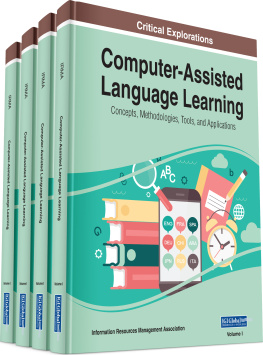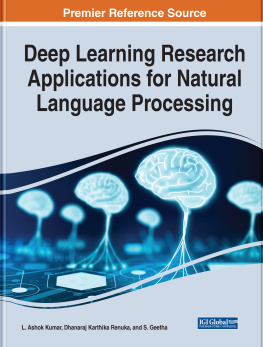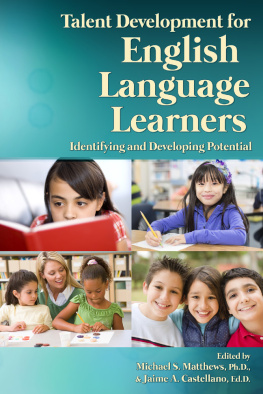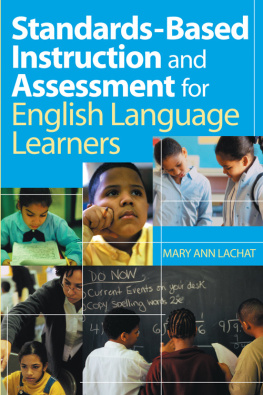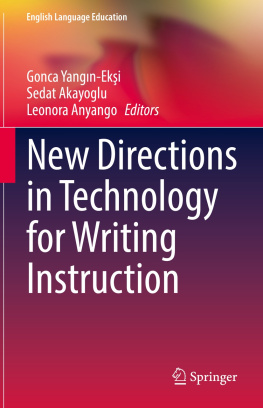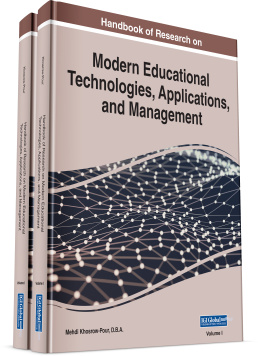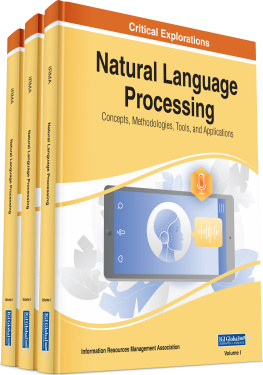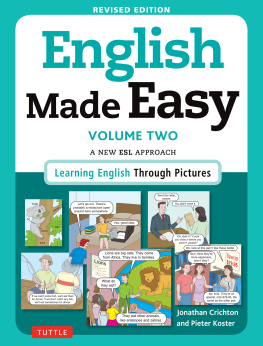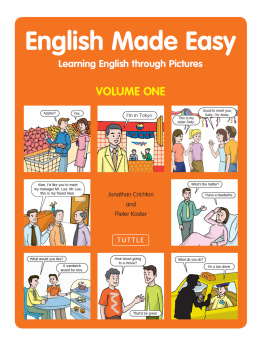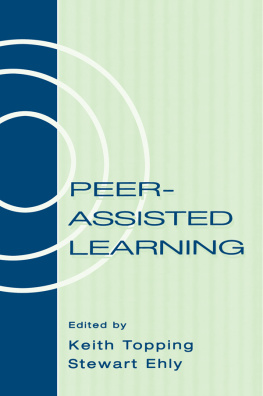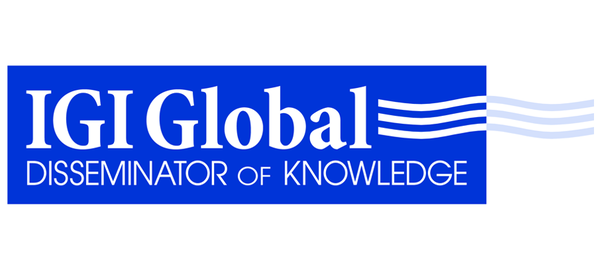Computer-Assisted Language Learning:
Concepts, Methodologies, Tools, and Applications
- Information Resources Management Association
USA
Published in the United States of America by IGI Global (an imprint of IGI Global) 701 E. Chocolate Avenue Hershey PA 17033 Tel: 717-533-8845 Fax: 717-533-8661 E-mail: cust@igi-global.com Web site: http://www.igi-global.com/reference
Copyright 2019 by IGI Global. All rights reserved. No part of this publication may be reproduced, stored or distributed in any form or by any means, electronic or mechanical, including photocopying, without written permission from the publisher.
Product or company names used in this set are for identification purposes only. Inclusion of the names of the products or companies does not indicate a claim of ownership by IGI Global of the trademark or registered trademark.
Library of Congress Cataloging-in-Publication Data
Names: Information Resources Management Association, editor.
Title: Computer-assisted language learning : concepts, methodologies, tools,
and applications / Information Resources Management Association, editor.
Description: Hershey, PA : Information Science Reference, [2019] | Includes
bibliographical references.
Identifiers: LCCN 2018034031| ISBN 9781522576631 (hardcover) | ISBN
9781522576648 (ebook)
Subjects: LCSH: Language and languages--Computer-assisted learning.
Classification: LCC P53.28 .C66255 2019 | DDC 418.0078/5--dc23 LC record available at https://lccn.loc.gov/2018034031
British Cataloguing in Publication Data
A Cataloguing in Publication record for this book is available from the British Library.
All work contributed to this book is new, previously-unpublished material. The views expressed in this book are those of the authors, but not necessarily of the publisher.
Editor-in-Chief
Mehdi Khosrow-Pour, DBA
Information Resources Management Association, USA
Associate Editors
Steve Clarke, University of Hull, UK
Murray E. Jennex, San Diego State University, USA
Annie Becker, Florida Institute of Technology, USA
Ari-Veikko Anttiroiko, University of Tampere, Finland
Editorial Advisory Board
Sherif Kamel, American University in Cairo, Egypt
In Lee, Western Illinois University, USA
Jerzy Kisielnicki, Warsaw University, Poland
Amar Gupta, Arizona University, USA
Craig van Slyke, University of Central Florida, USA
John Wang, Montclair State University, USA
Vishanth Weerakkody, Brunel University, UK
Preface
The constantly changing landscape of Computer-Assisted Language Learning makes it challenging for experts and practitioners to stay informed of the fields most up-to-date research. That is why Information Science Reference is pleased to offer this four-volume reference collection that will empower students, researchers, and academicians with a strong understanding of critical issues within Computer-Assisted Language Learning by providing both broad and detailed perspectives on cutting-edge theories and developments. This reference is designed to act as a single reference source on conceptual, methodological, technical, and managerial issues, as well as to provide insight into emerging trends and future opportunities within the discipline.
Computer-Assisted Language Learning: Concepts, Methodologies, Tools, and Applications is organized into seven distinct sections that provide comprehensive coverage of important topics. The sections are:
- 1. Fundamental Concepts and Theories;
- 2. Development and Design Methodologies;
- 3. Tools and Technologies;
- 4. Utilization and Applications;
- 5. Organizational and Social Implications;
- 6. Critical Issues and Challenges; and
- 7. Emerging Trends.
The following paragraphs provide a summary of what to expect from this invaluable reference tool.
Section 1, Fundamental Concepts and Theories, serves as a foundation for this extensive reference tool by addressing crucial theories essential to the understanding of Computer-Assisted Language Learning. Introducing the book is An Overview of EFL Teachers' Individual Differences in CALL by Samaneh Yadollahi: a great foundation laying the groundwork for the basic concepts and theories that will be discussed throughout the rest of the book. Section 1 concludes and leads into the following portion of the book with a nice segue chapter, Local Norms in CALL Language Practice by Jonathan R. White.
Section 2, Development and Design Methodologies, presents in-depth coverage of the conceptual design and architecture of Computer-Assisted Language Learning. Opening the section is Improve the Flipped Classroom With Universal Design for Learning by Thomas J. Tobin and Barbi Honeycutt. Through case studies, this section lays excellent groundwork for later sections that will get into present and future applications for Computer-Assisted Language Learning. The section concludes with an excellent work by Vehbi Turel, Intelligent Design of the Post-Listening Tasks in Interactive Multimedia Listening Environments.
Section 3, Tools and Technologies, presents extensive coverage of the various tools and technologies used in the implementation of Computer-Assisted Language Learning. The first chapter, The Effectiveness of Multiple Media Tools in L2 Listening: A Meta-Analysis by Tingting Kang, lays a framework for the types of works that can be found in this section. The section concludes with Mobile-Assisted Language Learning Experiences by Daesang Kim, Daniel Ruecker, and Dong-Joong Kim. Where Section 3 described specific tools and technologies at the disposal of practitioners, Section 4 describes the use and applications of the tools and frameworks discussed in previous sections.
Section 4, Utilization and Applications, describes how the broad range of Computer-Assisted Language Learning efforts has been utilized and offers insight on and important lessons for their applications and impact. The first chapter in the section is Using the Flipped Classroom to Improve Knowledge Creation of Master's-Level Students in Engineering written by Sachin Ahuja. This section includes the widest range of topics because it describes case studies, research, methodologies, frameworks, architectures, theory, analysis, and guides for implementation. The breadth of topics covered in the section is also reflected in the diversity of its authors, from countries all over the globe. The section concludes with Learning Language Through Facebook by Vera Monika Leier, a great transition chapter into the next section.
Section 5, Organizational and Social Implications, includes chapters discussing the organizational and social impact of Computer-Assisted Language Learning. The section opens with How Virtual Work Informs Virtual Learning by Lonnie R. Morris, Christine Morse, and Ta Karra Jones. This section focuses exclusively on how these technologies affect human lives, either through the way they interact with each other or through how they affect behavioral/workplace situations. The section concludes with The Role of Teachers and Their Beliefs in Implementing Technology-Mediated Language Learning by Geoff Lawrence.
Section 6, Critical Issues and Challenges, presents coverage of academic and research perspectives on Computer-Assisted Language Learning tools and applications. The section begins with Facebook Discussion to Enhance English Learners' Metacognitive Strategies by Pei-Ling Yang. Chapters in this section will look into theoretical approaches and offer alternatives to crucial questions on the subject of Computer-Assisted Language Learning. The section concludes with A Qualitative Study on CALL Knowledge and Materials Design by Olcay Sert and Li Li.

